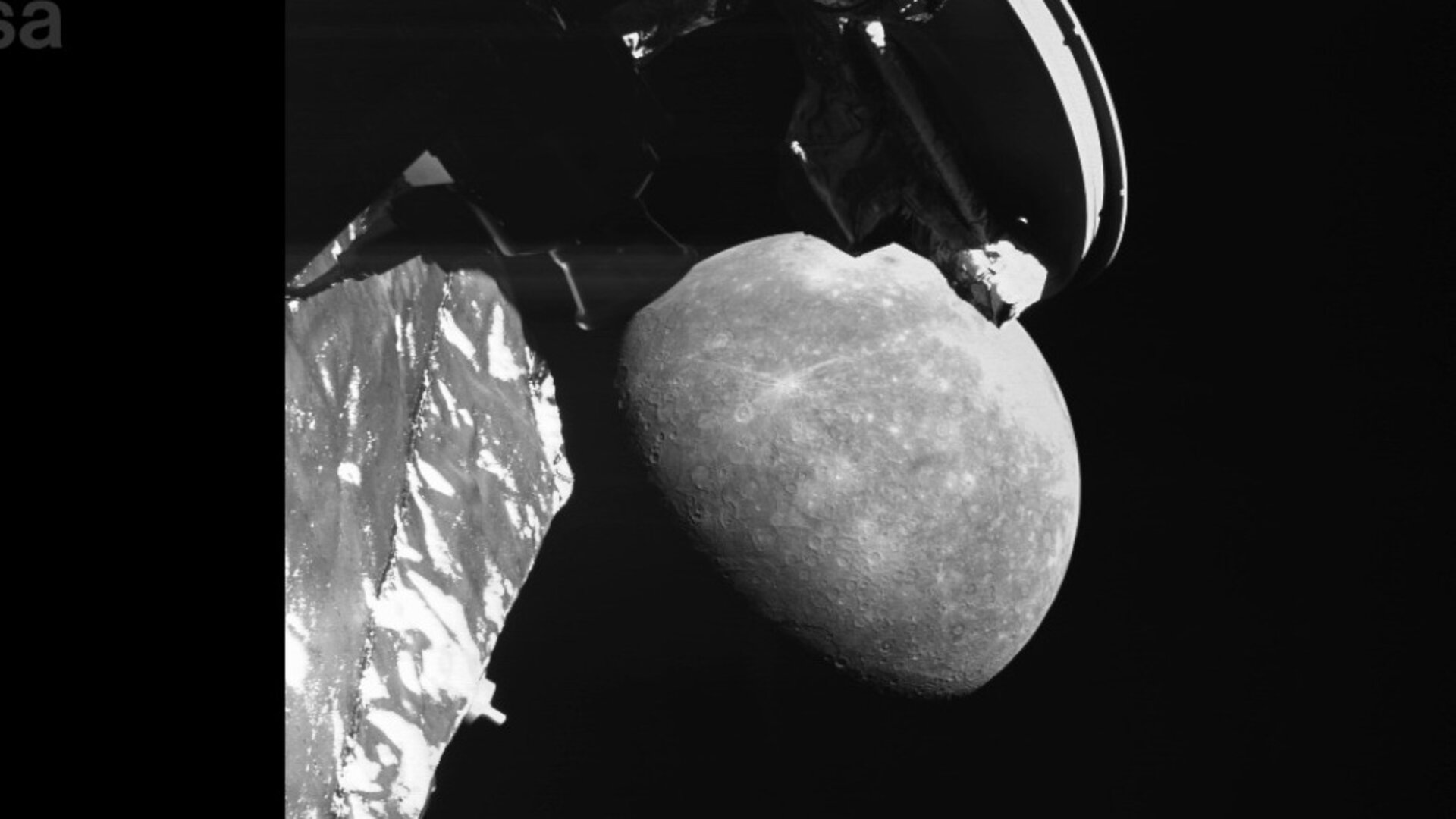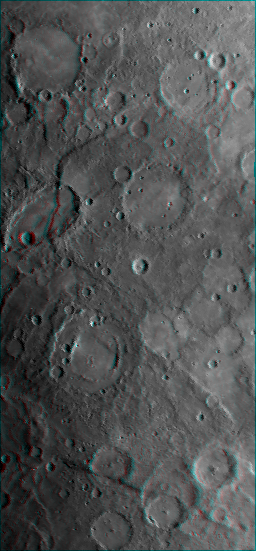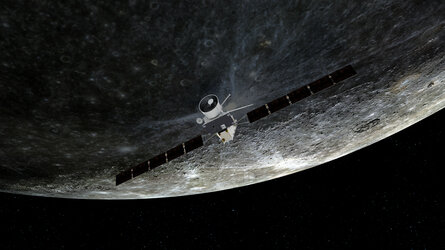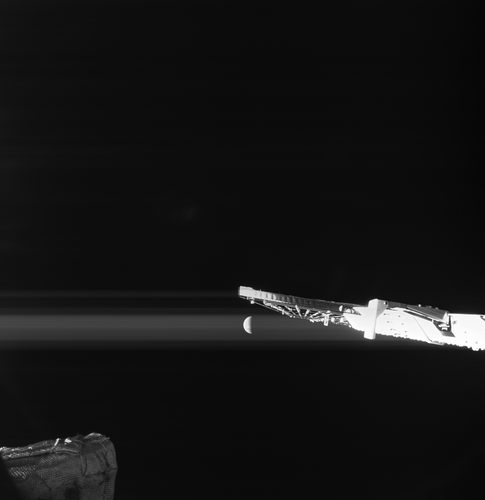BepiColombo’s third Mercury flyby: the movie
Watch Mercury appear from the shadows as the ESA/JAXA BepiColombo spacecraft sped by the planet’s night side during its 19 June 2023 close flyby, and enjoy a special flyover of geologically rich terrain, along with a bonus 3D scene.


Access the video
In the first part of the movie, composed of 217 images captured by BepiColombo’s monitoring camera M-CAM 3, the planet’s illuminated side quickly appears in the spacecraft’s field of view, showing off a bounty of geological features on its surface. The planet’s terminator – the divide between day and night – becomes more distinctive from afar, adding to the beauty of the image sequence. At one point Mercury momentarily appears to hang between the spacecraft’s body and antenna before the spacecraft speeds away.
The image sequence starts from 19:46:25 UTC on 19 June 2023, at an altitude of 1 789 km above the planet’s surface, and ends at 20:34:25 UTC on 20 June 2023, when BepiColombo was 331 755 km away. The image cadence was roughly once per minute around closest approach, but much slower in the later phases.
Fly over Mercury’s surface
The second part of the movie cuts to a flyover of a special region of interest featuring the 600 km-long curved escarpment known as Beagle Rupes, and the 218 km-wide Manley Crater, newly named by the International Astronomical Union for the Jamaican artist Edna Manley. Beagle Rupes cuts through an elongated impact crater named Sveinsdóttir.
The flyover begins looking down vertically, with east towards the top of the frame. The viewpoint then swoops down and in to focus on Beagle Rupes and Sveinsdóttir Crater, then looping round so the viewpoint migrates from east to south. It then tracks south to bring Manley Crater into the centre, with the straight scarp known as Challenger Rupes to its left, before rotating the view to bring north back to the top. At the end, the animated topography fades out and the projected image used for 3D reconstruction appears. Regions like these will be important for BepiColombo’s main science mission, to learn more about Mercury’s geological history.
The scene has been reconstructed using the ‘shape from shading’ technique. More than 400 years ago, Galileo Galilei noticed that surface regions on Earth’s Moon that tilt away from the Sun appear darker, and those facing the Sun appear brighter. The shape from shading algorithm builds on this fact. It takes the brightness of BepiColombo’s images of Mercury and infers the surface slope. With the surface slope, topographic maps can be created. This particular flyover view is based on a coarser digital elevation model from NASA’s Messenger, and the BepiColombo image. Shape from shading uses the image to refine the initial topography, uncover small geologic features, and predict more accurate slopes. The heights are not to scale.
Music and AI
Music was composed for the sequence by ILĀ, with the assistance of AI tools developed by the Machine Intelligence for Musical Audio (MIMA) group, University of Sheffield. Music from the previous two flyby movies composed by Maison Mercury Jones’ creative director ILĀ (formerly known as Anil Sebastian) and Ingmar Kamalagharan was given to the AI tool to suggest seeds for the new composition, which ILĀ then chose from to edit and weave together with other elements into the new piece. The team at the University of Sheffield has developed an Artificial Musical Intelligence (AMI), a large-scale general-purpose deep neural network that can be personalised to individual musicians and use cases.
The project with the University of Sheffield is aimed at exploring the boundaries of the ethics of AI creativity, while also emphasising the essential contributions of the (human) composer.
A bonus 3D scene

Part of the region covered by the flyover sequence has also been reconstructed as a 3D anaglyph in this image. Use red-green/blue glasses to best enjoy this view.
The image was taken from a distance of about 2 982 km, 17 minutes after closest approach, and covers an area roughly 1325.5 km x 642 km.
The topography at this site has also been reconstructed using the ‘shape from shading’ technique. The topography is used to generate anaglyphs that give a visual impression of the terrain. The heights are scaled by a factor of 12.5 to optimize the visual experience in front of a computer or mobile screen.
See here for an annotated image capturing some of the features seen in this image and flyover scene.
Notes for editors
The 19 June gravity assist manoeuvre was the third at Mercury and the sixth of nine planetary flybys overall. During its seven-year cruise to the smallest and innermost planet of the Solar System, BepiColombo makes one flyby at Earth, two at Venus and six at Mercury to help steer on course for Mercury orbit in 2025. The Mercury Transfer Module carries two science orbiters: ESA’s Mercury Planetary Orbiter and JAXA’s Mercury Magnetospheric Orbiter. They will operate from complementary orbits to study all aspects of mysterious Mercury, from its core to surface processes, magnetic field and exosphere, to better understand the origin and evolution of a planet close to its parent star.
For more information, please contact:
ESA Media Relations
media@esa.int














 Germany
Germany
 Austria
Austria
 Belgium
Belgium
 Denmark
Denmark
 Spain
Spain
 Estonia
Estonia
 Finland
Finland
 France
France
 Greece
Greece
 Hungary
Hungary
 Ireland
Ireland
 Italy
Italy
 Luxembourg
Luxembourg
 Norway
Norway
 The Netherlands
The Netherlands
 Poland
Poland
 Portugal
Portugal
 Czechia
Czechia
 Romania
Romania
 United Kingdom
United Kingdom
 Slovenia
Slovenia
 Sweden
Sweden
 Switzerland
Switzerland





























